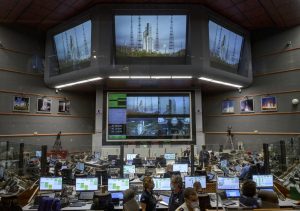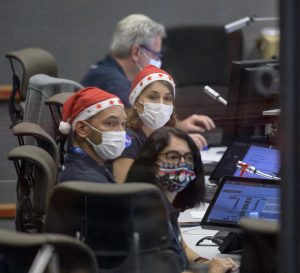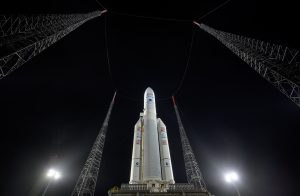The boosters have ignited, and we have liftoff! The Ariane 5 launcher carrying NASA’s James Webb Space Telescope launched into space at 7:20 am EST from Europe’s Spaceport in French Guiana.
Webb Mission Moving to Automated Countdown Activities
Webb has completed internal checks. All ground stations and the spacecraft are go for launch. Spacecraft and launch engineers at the Jupiter Control Center at Europe’s Spaceport in French Guiana and at the Mission Operations Center at the Space Telescope Science Institute in Baltimore, Maryland, have confirmed that Webb is on internal battery and is in its final launch configuration.
At seven minutes before launch, computers will initiate all Ariane 5 automatic countdown activities. The Ariane 5 will launch unless computers detect an issue, ground controllers initiate a stop, or the Webb team requests a hold due to a concern.
During liftoff the two solid propellant boosters — known as EAPs, from the French Etage d’Acceleration à Poudre – ignite and, along with the main stage engine, power the Ariane 5 up and away from the pad. The EAP boosters are the largest solid rocket boosters ever produced by European industry, providing roughly 92% of the total thrust at liftoff.

Ariane 5 Fueling is Complete
Fueling for both the main and upper stages of the Ariane 5 rocket is now complete.
In preparation for launch scheduled for no earlier than 7:20 am EST (9:20 am GFT). The cryogenic arms attached to the Ariane 5 are now supplying top-up fuel until liftoff. All systems are being continually measured to monitor the readiness of Ariane 5 to launch and the condition of its precious cargo.
We Are Go For Launch!
Webb has been confirmed as being go for launch, and the countdown clock was started! With weather reports looking favorable, the team authorized fueling of the Ariane 5, which began at 3 am EST.
Arianespace will measure winds at high altitude with the help of balloons to ensure absolute safety for the launch. Meanwhile the team continues to monitor Webb which is kept in a stable condition in the fairing. The team is monitoring temperatures, relative humidity, and cleanliness of the air entering the fairing – critical parameters to keep Webb cool, dry, and clean before liftoff.
Our broadcast of launch will begin at 6 am and can be watched on nasa.gov/live. You can also follow along on the NASA app, and on social with the hashtag #unfoldtheuniverse.

Key Milestones After Liftoff
Both immediately after launch and over the following weeks, the James Webb Space telescope will pass through numerous milestones on its journey of approximately 1 million miles to its final orbit around the second Lagrange point, commonly known as L2.
NASA has a detailed plan to deploy the Webb Space Telescope over a roughly two-week period. For details on any particular milestone – or to get updates on how far along Webb is in the process – please read about the deployments here. You may also watch a visualization.
The process involves hundreds of individual deployments. It is not an automatic, hands-off sequence; it is human-controlled. This means that the order, location, timing, and duration of deployments may change. However, the default order and approximate timing is as follows:
First hour:
Liftoff
~9 minutes: main stage separation
~27 minutes: upper stage separation
~33 minutes: solar array deployed
First Day
~12.5 hours: Midcourse correction burn (MCC1a)
~1 day: Release and motion test of the gimbaled antenna assembly
. . . and on
2 days: Midcourse correction burn (MCC1 b)
3 days: Forward sunshield pallet deployment
3 days: Aft sunshield pallet deployment
4 days: Deployable tower assembly
5 days: Aft momentum flap
5 days: Sunshield covers release
6 days: Sunshield port mid-boom and sunshield starboard mid-boom
7 days: Sunshield layer tensioning begins
8 days: Sunshield layer tensioning complete
10 days: Secondary mirror deployment begins and is completed
11 days: Aft Deployed Instrument Radiator
12 days: Port primary mirror wing deployment begins and is completed
13 days: Starboard primary mirror wing deployment begins and is completed
13 days: Webb is fully deployed
15-24 days: Individual mirror segment movements
29 days: Midcourse correction burn (MCC2)/L2 insertion burn
29.5 days: Orbit insertion complete
Favorable Weather Expected for Dec. 25 Launch
The latest weather forecast has arrived and we are still go for launch tomorrow!
The target launch date for the James Webb Space Telescope is Dec. 25. A 32-minute launch window opens at 7:20 a.m. EST in Kourou, French Guiana (9:20 a.m. GFT/12:20 UTC).

Join us to Watch the Webb Launch Live
Webb has been installed onto the Ariane 5 rocket in preparation for launch at 7:20 a.m. Eastern time on Saturday, Dec. 25, 2021. We asked Amber Straughn, Webb deputy project scientist for communications, to tell us how people can watch the launch live online – and how to join the worldwide virtual Webb launch watch party:
As we are all eagerly anticipating launch, you might be wondering how to watch the launch and what to expect. Good news! NASA and its partners are planning a launch broadcast celebration that will be viewable in several different ways. Live countdown commentary and launch broadcast will begin at 6 a.m. EST (11:00 UTC) on Dec. 25 and air on NASA Television and the agency’s website, as well as YouTube, Twitter, Facebook, LinkedIn, Twitch, Daily Motion, Theta.TV, and NASA’s App. You can also join the Facebook event to watch the launch live and interact with others watching the launch. The launch broadcast will continue until approximately one hour past launch, to follow the first several critical milestones post-launch. The actual launch window opens at 7:20 a.m. EST (12:20 UTC) and lasts for 31 minutes – we can launch at any point during that window.
The launch broadcast will include exciting scenes from the launch site in Kourou (naturally!), along with commentary from mission experts from both NASA’s Goddard Space Flight Center and the Mission Operations Center at the Space Telescope Science Institute. In the program you can also expect to see extraordinary video sequences showing construction of the telescope, in-person presentations about key technology, and cutting-edge animations depicting how it will unfold once it gets to space. Tune in to see an exciting new way to learn about the mission science and engineering. There might even be a launch event near you.
After the broadcast is over, follow the progress of commissioning by keeping an eye on our website and social media (Twitter, Facebook, & Instagram), and of course this blog. We will have almost-daily updates here for the first couple of weeks post-launch, and then will go back to a roughly weekly cadence for technical updates.
But you don’t have to wait until launch day to join in on the excitement. Check out the Journey to Space YouTube series, the Elements YouTube series, and if you are the creative type, submit art for our #UnfoldTheUniverse challenge. Find out even more “Need to Know” information here!
I personally cannot believe the day is almost here. I’m so very excited for launch!
—Amber Straughn, Webb deputy project scientist for communications, NASA’s Goddard Space Flight Center
By Jonathan Gardner, Webb deputy senior project scientist, NASA’s Goddard Space Flight Center
And Alexandra Lockwood, project scientist for Webb science communications, Space Telescope Science Institute
NASA, Partners Complete Webb Rocket Rollout
NASA’s James Webb Space Telescope – inside the Ariane 5 rocket it will ride to space – has arrived at its final location on Earth: the Arianespace ELA-3 launch complex at Europe’s Spaceport located near Kourou, French Guiana. Webb is scheduled for liftoff at 7:20 am EST Saturday, Dec. 25. With Webb and its rocket securely on the pad, the team will run electrical diagnostics to ensure all lights are green for launch. Teams will power on the observatory while at the launch pad to run one final aliveness test to ensure all systems have power and are working before liftoff.

NASA, Partners Roll Out Webb to Launch Pad
NASA’s James Webb Space Telescope has begun its stately rollout to the Arianespace ELA-3 launch complex at Europe’s Spaceport located near Kourou, French Guiana. Arianespace and NASA will closely monitor the vitals of Webb and the Ariane 5 rocket during the nearly two-hour process. Webb is scheduled for liftoff at 7:20 am EST Saturday, Dec. 25.

NASA, Partners Confirm Webb Launch on Dec. 25
NASA, ESA (European Space Agency), and Arianespace confirmed a targeted launch date of Saturday, Dec. 25, for the James Webb Space Telescope. A 32-minute launch window opens at 7:20 a.m. EST in Kourou, French Guiana (9:20 a.m. GFT/12:20 UTC).
An Ariane 5 rocket will lift off from Europe’s Spaceport carrying NASA’s next-generation space observatory.

Related Link
